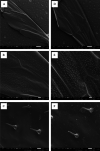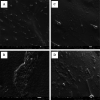Honeybee wings hold antibiofouling and antimicrobial clues for improved applications in health care and industries
- PMID: 37091819
- PMCID: PMC10113161
- DOI: 10.3934/microbiol.2023018
Honeybee wings hold antibiofouling and antimicrobial clues for improved applications in health care and industries
Abstract
Natural surfaces with remarkable properties and functionality have become the focus of intense research. Heretofore, the natural antimicrobial properties of insect wings have inspired research into their applications. The wings of cicadas, butterflies, dragonflies, and damselflies have evolved phenomenal anti-biofouling and antimicrobial properties. These wings are covered by periodic topography ranging from highly ordered hexagonal arrays of nanopillars to intricate "Christmas-tree" like structures with the ability to kill microbes by physically rupturing the cell membrane. In contrast, the topography of honeybee wings has received less attention. The role topography plays in antibiofouling, and antimicrobial activity of honeybee wings has never been investigated. Here, through antimicrobial and electron microscopy studies, we showed that pristine honeybee wings displayed no microbes on the wing surface. Also, the wings displayed antimicrobial properties that disrupt microbial cells and inhibit their growth. The antimicrobial activities of the wings were extremely effective at inhibiting the growth of Gram-negative bacterial cells when compared to Gram-positive bacterial cells. The fore wing was effective at inhibiting the growth of Gram-negative bacteria compared to Gram-positive samples. Electron microscopy revealed that the wings were studded with an array of rough, sharp, and pointed pillars that were distributed on both the dorsal and ventral sides, which enhanced anti-biofouling and antimicrobial effects. Our findings demonstrate the potential benefits of incorporating honeybee wings nanopatterns into the design of antibacterial nanomaterials which can be translated into countless applications in healthcare and industry.
Keywords: anti-biofouling; antimicrobial; bacteria; honeybee; wings; workers.
© 2023 the Author(s), licensee AIMS Press.
Conflict of interest statement
Conflicts of interest: The authors declare that they have no competing interests.
Figures





Similar articles
-
Multi-biofunctional properties of three species of cicada wings and biomimetic fabrication of nanopatterned titanium pillars.J Mater Chem B. 2019 Feb 28;7(8):1300-1310. doi: 10.1039/c8tb03295e. Epub 2019 Feb 1. J Mater Chem B. 2019. PMID: 32255169
-
Bactericidal activity of self-assembled palmitic and stearic fatty acid crystals on highly ordered pyrolytic graphite.Acta Biomater. 2017 Sep 1;59:148-157. doi: 10.1016/j.actbio.2017.07.004. Epub 2017 Jul 5. Acta Biomater. 2017. PMID: 28688988
-
The function of resilin in honeybee wings.J Exp Biol. 2015 Jul;218(Pt 13):2136-42. doi: 10.1242/jeb.117325. Epub 2015 May 18. J Exp Biol. 2015. PMID: 25987733
-
Nature-Inspired Surface Structures Design for Antimicrobial Applications.Int J Mol Sci. 2023 Jan 10;24(2):1348. doi: 10.3390/ijms24021348. Int J Mol Sci. 2023. PMID: 36674860 Free PMC article. Review.
-
Nature-Inspired Antimicrobial Surfaces and Their Potential Applications in Food Industries.Foods. 2022 Mar 16;11(6):844. doi: 10.3390/foods11060844. Foods. 2022. PMID: 35327267 Free PMC article. Review.
Cited by
-
In Vitro Antimicrobial Efficacy Assessment of Ethanolic, Aqueous, and Dual Solvent Extracts of Mushroom Ganoderma lucidum: Genomic and Morphological Analysis.Antibiotics (Basel). 2024 Nov 21;13(12):1109. doi: 10.3390/antibiotics13121109. Antibiotics (Basel). 2024. PMID: 39766499 Free PMC article.
References
-
- Oopath SV, Baji A, Abtahi M, et al. Nature-inspired biomimetic surfaces for controlling bacterial attachment and biofilm development. Adv Mater Interfaces. 2023;10:2201425. doi: 10.1002/admi.202201425. - DOI
LinkOut - more resources
Full Text Sources
Molecular Biology Databases
